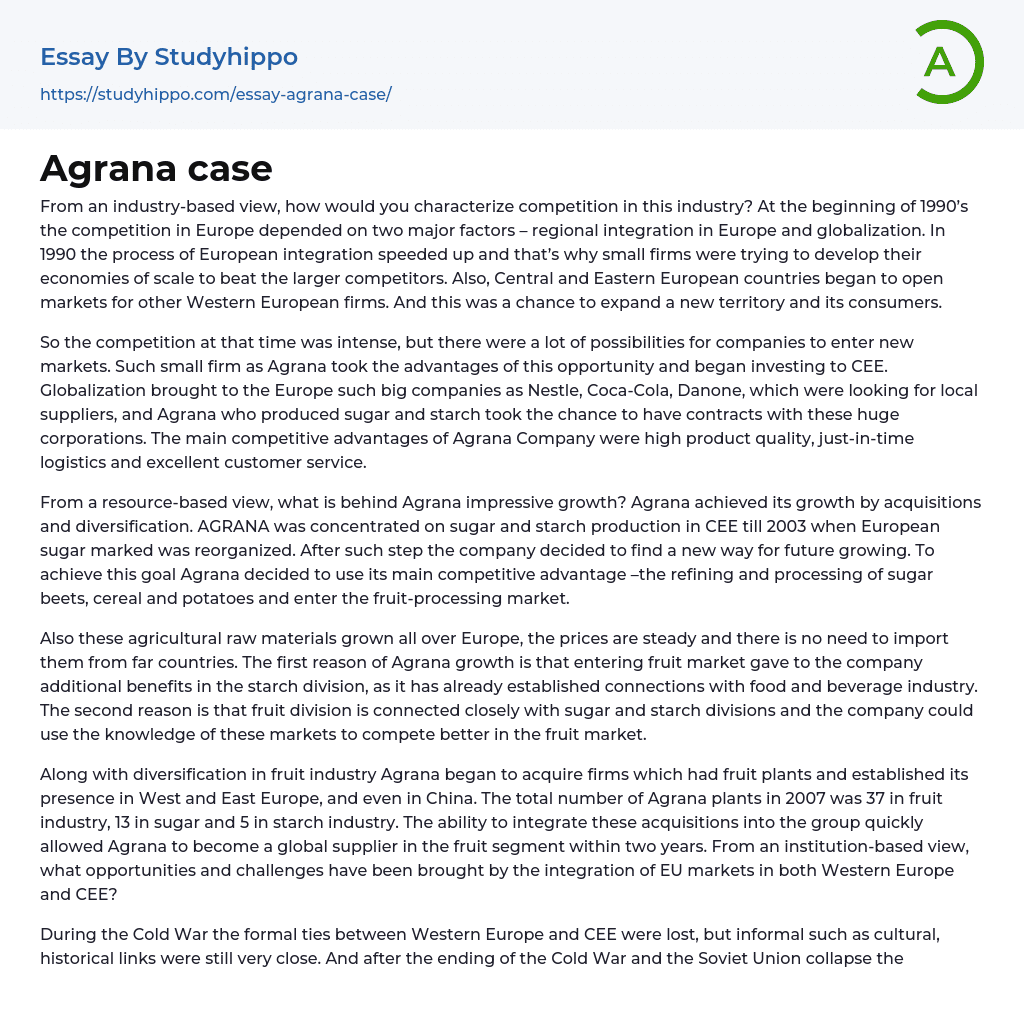From an industry-based view, how would you characterize competition in this industry? At the beginning of 1990’s the competition in Europe depended on two major factors – regional integration in Europe and globalization. In 1990 the process of European integration speeded up and that’s why small firms were trying to develop their economies of scale to beat the larger competitors. Also, Central and Eastern European countries began to open markets for other Western European firms. And this was a chance to expand a new territory and its consumers.
So the competition at that time was intense, but there were a lot of possibilities for companies to enter new markets. Such small firm as Agrana took the advantages of this opportunity and began investing to CEE. Globalization brought to the Europe such big companies as Nestle, Coca-Cola, Danone, which were l
...ooking for local suppliers, and Agrana who produced sugar and starch took the chance to have contracts with these huge corporations. The main competitive advantages of Agrana Company were high product quality, just-in-time logistics and excellent customer service.
From a resource-based view, what is behind Agrana impressive growth? Agrana achieved its growth by acquisitions and diversification. AGRANA was concentrated on sugar and starch production in CEE till 2003 when European sugar marked was reorganized. After such step the company decided to find a new way for future growing. To achieve this goal Agrana decided to use its main competitive advantage –the refining and processing of sugar beets, cereal and potatoes and enter the fruit-processing market.
Also these agricultural raw materials grown all over Europe, the prices are steady and there i
no need to import them from far countries. The first reason of Agrana growth is that entering fruit market gave to the company additional benefits in the starch division, as it has already established connections with food and beverage industry. The second reason is that fruit division is connected closely with sugar and starch divisions and the company could use the knowledge of these markets to compete better in the fruit market.
Along with diversification in fruit industry Agrana began to acquire firms which had fruit plants and established its presence in West and East Europe, and even in China. The total number of Agrana plants in 2007 was 37 in fruit industry, 13 in sugar and 5 in starch industry. The ability to integrate these acquisitions into the group quickly allowed Agrana to become a global supplier in the fruit segment within two years. From an institution-based view, what opportunities and challenges have been brought by the integration of EU markets in both Western Europe and CEE?
During the Cold War the formal ties between Western Europe and CEE were lost, but informal such as cultural, historical links were still very close. And after the ending of the Cold War and the Soviet Union collapse the great opportunities occurred for European companies to enter the market of CEE. Because of high pressure of the EU integration, CEE has created attractive investment conditions for western firms, but most of them failed. The main challenge for EU markets is the Common Agricultural Policy (CAP) of EU which regulates the quantity of sugar production, controls prices.
After EU passed sugar reforms which reduced subsidies
and price regulation the competition grew at the market. As a result a lot of companies closed their production. From an international perspective, what challenges do you foresee Agrana facing as it continues its expansion into other regions, such as East Asia? The main advantage of expanding to East Asia is the low labor cost and new big market. But this expansion can also have big disadvantages such as access to agricultural products and prices for them.
In order to protect domestic industries some country may impose tariffs on imported fruits, sugar and starch; as a result the prices will go up and Agrana can lose its competitive advantage. And it can be also a problem to buy these products on local markets because they can be low-quality products or there will be no needed quantity of them available. The next challenge is that laws and traditions in East Asia countries are pretty much different from countries in West and East Europe. And if Agrana won’t change its marketing strategy it can lose supplying manufactures and potential customers.
- Money essays
- Financial Accounting essays
- Market Segmentation essays
- Supply And Demand essays
- Purchasing essays
- Forecasting essays
- Legacy essays
- Bank essays
- Corporate Finance essays
- Financial News essays
- Financial Ratios essays
- Financial Services essays
- Free Market essays
- Shareholder essays
- Personal finance essays
- Equity essays
- Financial Crisis essays
- Banking essays
- Credit Card essays
- Currency essays
- Debt essays
- Gold essays
- Loan essays
- Enron Scandal essays
- Foreign Exchange Market essays
- Investment essays
- Venture Capital essays
- Stock Market essays
- Retirement essays
- Donation essays
- Net Present Value essays
- Income Statement essays
- Commercial Bank essays
- Debit Card essays
- Deposit Account essays
- Subprime Lending essays
- Perfect Competition essays
- Underwriting essays
- Synergy essays
- Valuation essays
- Investing essays
- Asset essays
- Depreciation essays
- Discounted Cash Flow essays
- Foreign Direct Investment essays
- Funds essays
- Internal Rate Of Return essays
- Revenue essays
- Day Trading essays
- Futures Trading essays




